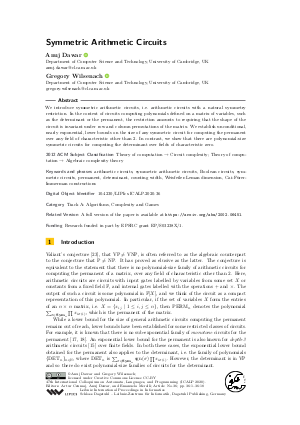Symmetric Arithmetic Circuits
Authors
Anuj Dawar  ,
Gregory Wilsenach
,
Gregory Wilsenach 
-
Part of:
Volume:
47th International Colloquium on Automata, Languages, and Programming (ICALP 2020)
Part of: Series: Leibniz International Proceedings in Informatics (LIPIcs)
Part of: Conference: International Colloquium on Automata, Languages, and Programming (ICALP) - License:
 Creative Commons Attribution 3.0 Unported license
Creative Commons Attribution 3.0 Unported license
- Publication Date: 2020-06-29
File

PDF
LIPIcs.ICALP.2020.36.pdf
- Filesize: 0.57 MB
- 18 pages
Document Identifiers
Related Versions
-
A full version of the paper is available at https://arxiv.org/abs/2002.06451.
Subject Classification
ACM Subject Classification
- Theory of computation → Circuit complexity
- Theory of computation → Algebraic complexity theory
Keywords
- arithmetic circuits
- symmetric arithmetic circuits
- Boolean circuits
- symmetric circuits
- permanent
- determinant
- counting width
- Weisfeiler-Leman dimension
- Cai-Fürer-Immerman constructions
Metrics
- Access Statistics
-
Total Accesses (updated on a weekly basis)
0Document
0Metadata
Abstract
We introduce symmetric arithmetic circuits, i.e. arithmetic circuits with a natural symmetry restriction. In the context of circuits computing polynomials defined on a matrix of variables, such as the determinant or the permanent, the restriction amounts to requiring that the shape of the circuit is invariant under row and column permutations of the matrix. We establish unconditional, nearly exponential, lower bounds on the size of any symmetric circuit for computing the permanent over any field of characteristic other than 2. In contrast, we show that there are polynomial-size symmetric circuits for computing the determinant over fields of characteristic zero.
Cite As Get BibTex
Anuj Dawar and Gregory Wilsenach. Symmetric Arithmetic Circuits. In 47th International Colloquium on Automata, Languages, and Programming (ICALP 2020). Leibniz International Proceedings in Informatics (LIPIcs), Volume 168, pp. 36:1-36:18, Schloss Dagstuhl – Leibniz-Zentrum für Informatik (2020)
https://doi.org/10.4230/LIPIcs.ICALP.2020.36
BibTex
@InProceedings{dawar_et_al:LIPIcs.ICALP.2020.36,
author = {Dawar, Anuj and Wilsenach, Gregory},
title = {{Symmetric Arithmetic Circuits}},
booktitle = {47th International Colloquium on Automata, Languages, and Programming (ICALP 2020)},
pages = {36:1--36:18},
series = {Leibniz International Proceedings in Informatics (LIPIcs)},
ISBN = {978-3-95977-138-2},
ISSN = {1868-8969},
year = {2020},
volume = {168},
editor = {Czumaj, Artur and Dawar, Anuj and Merelli, Emanuela},
publisher = {Schloss Dagstuhl -- Leibniz-Zentrum f{\"u}r Informatik},
address = {Dagstuhl, Germany},
URL = {https://drops.dagstuhl.de/entities/document/10.4230/LIPIcs.ICALP.2020.36},
URN = {urn:nbn:de:0030-drops-124430},
doi = {10.4230/LIPIcs.ICALP.2020.36},
annote = {Keywords: arithmetic circuits, symmetric arithmetic circuits, Boolean circuits, symmetric circuits, permanent, determinant, counting width, Weisfeiler-Leman dimension, Cai-F\"{u}rer-Immerman constructions}
}
Author Details
Funding
Research funded in part by EPSRC grant EP/S03238X/1.
References
-
M. Ajtai. Recursive construction for 3-regular expanders. Combinatorica, 14:379-416, 1994.

-
M. Anderson and A. Dawar. On symmetric circuits and fixed-point logics. Theory Comput. Syst., 60(3):521-551, 2017.

-
M. Anderson, A. Dawar, and B. Holm. Solving linear programs without breaking abstractions. J. ACM, 62, 2015.

- V. Arvind, F. Fuhlbrück, J. Köbler, and O. Verbitsky. On Weisfeiler-Leman invariance: Subgraph counts and related graph properties. In Fundamentals of Computation Theory - 22nd International Symposium, FCT 2019, pages 111-125, 2019. URL: https://doi.org/10.1007/978-3-030-25027-0_8.
- A. Atserias, A. Dawar, and J. Ochremiak. On the power of symmetric linear programs. In 34th Annual ACM/IEEE Symposium on Logic in Computer Science, LICS, pages 1-13, 2019. URL: https://doi.org/10.1109/LICS.2019.8785792.
- W. Baur and V. Strassen. The complexity of partial derivatives. Theor. Comput. Sci., 22, 1983. URL: https://doi.org/10.1016/0304-3975(83)90110-X.
-
A. Blass, Y. Gurevich, and S. Shelah. On polynomial time computation over unordered structures. Journal of Symbolic Logic, 67(3):1093-1125, 2002.

-
J-Y. Cai, M. Fürer, and N. Immerman. An optimal lower bound on the number of variables for graph identification. Combinatorica, 12(4):389-410, 1992.

-
A. Dawar. The nature and power of fixed-point logic with counting. ACM SIGLOG News, 2(1):8-21, 2015.

-
A. Dawar and D. Richerby. The power of counting logics on restricted classes of finite structures. In CSL 2007:Computer Science Logic, volume 4646 of LNCS, pages 84-98. Springer, 2007.

- A. Dawar and P. Wang. Definability of semidefinite programming and Lasserre lower bounds for CSPs. In 32nd Annual ACM/IEEE Symposium on Logic in Computer Science, LICS, 2017. URL: https://doi.org/10.1109/LICS.2017.8005108.
-
A. Dawar and G. Wilsenach. Symmetric circuits for rank logic. In 27th EACSL Annual Conference on Computer Science Logic, CSL 2018, pages 20:1-20:16, 2018.

-
L. Denenberg, Y. Gurevich, and S. Shelah. Definability by constant-depth polynomial-size circuits. Information and Control, 70:216-240, 1986.

- M. A. Forbes, M. Kumar, and R. Saptharishi. Functional lower bounds for arithmetic circuits and connections to boolean circuit complexity. In 31st Conference on Computational Complexity, CCC 2016, pages 33:1-33:19, 2016. URL: https://doi.org/10.4230/LIPIcs.CCC.2016.33.
- D. Grigoriev and M. Karpinski. An exponential lower bound for depth 3 arithmetic circuits. In Proceedings of the Thirtieth Annual ACM Symposium on the Theory of Computing, pages 577-582, 1998. URL: https://doi.org/10.1145/276698.276872.
-
B. Holm. Descriptive Complexity of Linear Algebra. PhD thesis, University of Cambridge, 2010.

- M. Jerrum and M. Snir. Some exact complexity results for straight-line computations over semirings. J. ACM, 29:874-897, 1982. URL: https://doi.org/10.1145/322326.322341.
-
N. Kayal and R. Saptharishi. A selection of lower bounds for arithmetic circuits. In M. Agrawal and V. Arvind, editors, Perspectives in Computational Complexity. Birkhäuser Basel, 2014.

- J.M. Landsberg and N. Ressayre. Permanent v. determinant: An exponential lower bound assuming symmetry. In Proc. ACM Conference on Innovations in Theoretical Computer Science, pages 29-35. ACM, 2016. URL: https://doi.org/10.1145/2840728.2840735.
-
M. Otto. The logic of explicitly presentation-invariant circuits. In Computer Science Logic, 10th International Workshop, CSL '96, Annual Conference of the EACSL, pages 369-384, 1996.

- A. Shpilka and A. Wigderson. Depth-3 arithmetic circuits over fields of characteristic zero. Computational Complexity, 10:1-27, 2001. URL: https://doi.org/10.1007/PL00001609.
- A. Shpilka and A. Yehudayoff. Arithmetic circuits: A survey of recent results and open questions. Foundations and Trends in Theoretical Computer Science, 5(3-4):207-388, 2010. URL: https://doi.org/10.1561/0400000039.
- L. G. Valiant. Completeness classes in algebra. In Proceedings of the 11h Annual ACM Symposium on Theory of Computing STOC, pages 249-261, 1979. URL: https://doi.org/10.1145/800135.804419.
- H. Vollmer. Introduction to Circuit Complexity - A Uniform Approach. Texts in Theoretical Computer Science. An EATCS Series. Springer, 1999. URL: https://doi.org/10.1007/978-3-662-03927-4.
